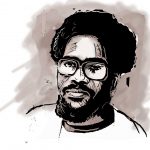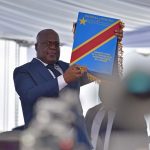Toward Sudan’s next revolution: what is to be done?
A popular revolt is spreading across Sudan. At stake is not just the fate of authoritarian President Omar al-Bashir, but the country’s whole power structure.
Author:
18 February 2019

Arrested at the beginning of the 1970s, the popular Sudanese poet Mahjoub Sharif wrote a fervent prayer on his way to prison:
When will it clear
The sky of our dear Khartoum,
When will it be healed
The country’s wound?
Some decades later, it appears his question is being answered. On the morning of 25 December 2018, the Sudanese capital woke to the resounding clamour of protest involving various opposition forces in the largest and most imposing demonstration the country has known since current President Omar al-Bashir’s Islamist movement arrived in power via a coup d’état in 1989.
The call to mobilisation was launched by the Professionals’ Assembly, which brings together the large doctors’, engineers’ and lawyers’ unions, and was echoed by the population and some political parties – a convergence that’s not happened in decades.
The initial stated aim of the Professionals’ Assembly, based in Khartoum, was to present the government with a note of the unions’ opposition to economic policy. But the political escalation raised the ambition of the group’s demands, including a letter to the presidential palace calling explicitly for the president’s resignation.
Faced with a stunning movement, succeeding across towns big and small, the government seems to be hesitating between cunning and flexibility – potentially resorting to brute force, which the country has become used to over the past three decades.
An unprecedented movement
Since its independence from the British in 1956, Sudan has experienced several popular revolutions, two of which successfully removed a totalitarian dictator: Commander Ibrahim Abboud in 1964 and General Jaafar Nimeiry in 1985. But the current revolt appears different in every respect from the previous ones.
If the former revolts both built on a trade-union movement at the height of its strength, and an organised political movement present across Sudan’s larger cities, especially in the capital, the current uprising took form in the cities far north of the capital, in places like Abara, a historically working-class centre and the birthplace of Sudanese trade unionism. It then spread rapidly, with the wave hitting nearby northern towns such as Berber and Damer then Danqala and Karima. The revolt moved east to include Qadarif, Port Sudan and Kasla, then west, to Abyad, Rahd and the area along the White Nile.
The popular movement is eclectic, bringing together many parts of the population. The political earthquake surprised the regime, which tends to concentrate its forces on the capital to prevent a coup. Beyond the strength and vitality of the movement, the clarity of its political demands has made the government anxious. Notwithstanding the present conjuncture dominated by hunger and poverty, these demands are not only economic. The United Nations’ Development Programme (UNDP) has estimated more than 20 million people live under the poverty line in Sudan, representing close to a third of the 66 million in such a position across all the Arab countries.
The slogans shouted by the protesters across the towns are essentially political. The chants raised most often are, “Freedom, peace and justice!” and “Revolution is the people’s choice!”, showing the depth of popular aspirations and the force of the idea of revolution.
Related article:
This qualitative leap – without preparation – has raised the struggle to an unprecedented level: despite the poverty and the hunger, the people have clearly expressed their desire to finish with the power of the Muslim Brotherhood–allied National Islamic Front and enter a new era. It’s also clear the Islamist movement has entirely run out of steam, leaving behind an oppressive heritage: a running down of the state at every level, from the economic to the political and cultural spheres, and even, paradoxically, in the religious sphere, given the ravages of the “diabolical” mixture of religion and corruption.
During a meeting with the lead editors of the Sudanese press, the secret service chief Salah Quoch said he thought the movement was a spontaneous revolt distant from the political parties. In exempting the parties from any responsibility, Quoch was only saying he thought the popular movement had no hope – a claim rapidly belied by the facts.
He attributed responsibility to agents provocateurs – trained and guided by Mossad – among the demonstrators and subversive forces. He focused particularly on the Sudan Liberation Movement, a Darfuri rebel group led by Abdul Wahid al-Nour. The accusation betrays the shock the government feels in the face of a revolution. The regions where the ruling National Congress Party’s offices have been ransacked (Atbara, Damer, and Berber) include in their social make up only negligible numbers of Darfuris and, indeed, are considered – by the regime, no less – as bastions of the Islamist movement.
Impressive demonstrations
The popular movement continues. Everything indicates the urban population has taken the initiative. The population across numerous towns and cities has braved the state of emergency and curfew. On 25 December 2018, many neighbourhoods were taken over by the mass of protesters. At the head of the procession marched the representatives of the unions of the various sectors as well as the heads of the political parties. The demonstration was the most impressive the country has known since Bashir’s 1989 coup.
Despite the state’s excessive force and use of live ammunition to disperse protesters, through their determination to challenge power, the people have expressed a clear message: the revolution is now in motion, and with ever more force and vitality. The centre of the capital now looks like a battlefield with massive deployments of armoured vehicles and soldiers. In the immediate term, the unions’ work has been crowned with success, as shown in the statement from the Professionals’ Assembly. It denounces the fact that authorities have:
“ … deployed security forces and soldiers by the thousands, supported by armoured vehicles, who have fired live ammunition on demonstrators in order to keep them from meeting with their civil society partners and political parties, and to prevent the popular Sudanese masses from entering the palace in order to deliver a memorandum calling for the resignation of the president.”
The unions have celebrated achieving a unity that has been beyond their grasp for decades: “We have strongly expressed our position, being the will of a united people.” The climate is of rediscovered confidence – the gathered forces have the impression of winning the first round, despite a death toll of 40, as estimated by medics.
This is the general feeling: the political opposition, represented mainly by the coalition of the National Consensus Forces (NDF) and the Sudanese Revolutionary Front (SRF, itself a coalition), held a meeting at the headquarters of the Communist Party in Khartoum before the 25 December march. Deciding to forget their differences, they expressed their intention to coordinate their efforts to bring about “the fall of the regime”.
A consensus was reached on the removal of Bashir from the presidency, the formation of a transitional presidential council and a future government of technocrats, whose task would be to prepare for a return to a political life of genuine party pluralism and the advent of a new regime. The objective was to accentuate the struggle to force the president’s resignation.
The various Islamist components of the government are in the throes of strong internal disagreements about to how to react, faced with revolt of the cities. In a feverish race to adapt, they met on Friday 21 December 2018. The leaders of the Islamist movement, itself split into several rival branches – the People’s Congress Party, led by Ali Al-Hajj; the al-Islah Movement, led by Ghazi Salahuddin Atabani; and Shura Council of the Islamic Movement, led by al-Islah Fateh Ezzeddine – have met General Kamal Abdul-Maarouf, chief of staff of the army. The idea of a military takeover was mentioned, which Abdul-Maarouf accepted in principle, and as something to discuss with other leading members of the general staff.
On the same day, the delegation met Sadiq al-Mahdi, the leader of the al-Umma Party, and opposition leaders, including of the SRF coalition. The meeting, chaired by al-Mahdi, prepared the ground for future negotiations on the resignation of the current executive, the establishment of a transitional period and the installation of a technocratic government.
The youth: An unknown force
But a new factor has come into play that should influence the course of events: the forces of youth, the real engine of popular revolt in all Sudanese cities. This young generation was born in the shadow of Islamist power, and so is distinct from generations familiar with the political parties that existed before Bashir.
It is a fundamentally rebellious generation, raised outside the field of sectarian polarisation. Many young people seek to rise above the usual arrangements between parties and would like to see the current movement go beyond the usual compromises, such as if the movement just ended with accepting a change in government. They aim, instead, for regime change and a break from the religious influence on politics.
It’s this aspiration for a true revolution that is expressed in the slogans chanted by the young people: “Freedom, peace, justice.” In other words, an active, decisive factor is now part of the political equation. It brings another vision of the future, which breaks with old practices and seeks to establish a modern state built on equality, law and new values. Current political leaders, especially in the opposition, are mostly of an advanced age. Young people demanding a real change will tend naturally toward the streets to express themselves politically. The coming period will therefore generate greater political turmoil, raising crucial choices and grave perils.
Related article:
Either the Islamist movement tries to take everyone by surprise by staging a palace coup (which would undoubtedly be met by strong popular opposition). Or, the Islamist contingents could make a pact with influential political figures such as Sadiq al-Mahdi, who appears more inclined to conciliatory solutions in line with his vision for a soft landing.
This could involve putting an end to power of the National Congress Party, setting in motion a transitional phase with a congress made up of all Sudanese political forces, including Islamists, to debate what government should come next. This solution would also be rejected by the population, especially by the younger generation, and the oppositional NDF coalition, as led by the former president of the bar association of Arab lawyers, Farouk Abu Issa.
The third possible option – clearly the preference of the people – is radical change, with the removal of Islamists from power and a break with the political past. Most likely to steer Sudan towards modern statehood, this solution of the youth and the revolutionary forces is precisely the one that will be fought most virulently by the traditional sectarian forces and the Islamist movement.
The current movement could collide with the militias of the Islamist movement, who would take action and not hesitate to open fire. The question is to what extent military and police forces will remain impassive in the face of such dangers. Will they enter the stage, as some hope, to support the movement and resolve the conflict in favour of the people, as in the two popular uprisings of 1964 and 1985?
All indications are that the Sudanese people’s uprising is continuing and growing in power, expressing its clear desire to put an end to the current regime. In parallel, marathon negotiations continue between various parties and political forces hoping to escape the crisis. The result remains in the balance.
This article first appeared in Europe Solidaire Sans Frontières.
Translated by Joe Hayns and Roberto Mozzachiodi. Tarek Cheikh is a Sudanese journalist.


